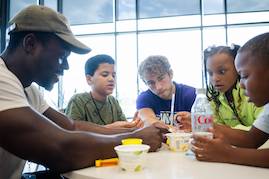About our Partnership
Our partnership with the Boys & Girls Club of Harrisonburg and Rockingham County (BGCHR) started in February 2021. JMU students who are members of JMU STEM Corps visit two Harrisonburg City clubs on Friday afternoons to engage BGCHR members in a series of lessons that demonstrate real-world applications of STEM practices while reinforcing science and math ideas learned in school. To ensure the latter, we consult with two Harrisonburg City Public School teachers who review each lesson and provide recommendations for better consistency with what and how the students are learning in school.


Curriculum
We use a curriculum developed by STEM Center director Kerry Cresawn that aims to model real-world integration of the STEM disciplines & practices, incorporates standards-aligned foundations, and fosters ways of thinking in STEM.
Key Features of our 2023-2024 Curriculum:
I. The why and how of technology in STEM: Fall semester lessons focus on technology while reinforcing ideas about energy. Specifically, we aim to motivate students to ask how technologies used in science and engineering work and to consider purpose, needs, and access when deciding between tools. We aim to lay foundations for this mindset by [1] providing opportunities for students to learn how a technology works by building a simple version and comparing it to the digital tool and [2] using familiar and foundational concepts as context for technology applications. For this version of the curriculum, we chose ideas about sources of energy and what it means to define energy as the ability to do work.
II. Spatial Reasoning: Spring semester lessons provide opportunities for students to practice spatial thinking and reasoning. In three of the lessons, we do this by designing lessons around a global problem (natural disasters, clean drinking water access, and polluted oceans) and incorporate a world map. By practicing K-5 mapping skills to better understand why earthquakes, for example, are more serious in some parts of the world versus others, students are being introduced to how information we find on maps helps us to understand and address problems through STEM. In the next two lessons, we incorporate spatial reasoning by designing lessons around an accessibility challenge for which space and direction must be considered in their design decisions. These challenges were safer wheelchair ramps for Harrisonburg and a tactile map of the county fair for someone with visual impairment.
III. Empathy: Across the two semesters, we aim to build on students' understanding of engineering practices and ways of thinking. In the Fall lessons on technology & energy, we introduce the engineering design process and distinguish between science and engineering practices. In the Spring lessons (natural disasters, resource challenges, and accessibility spaces), we introduce opportunities for students to develop a design-thinking mindset with a focus on the role that empathy plays in addressing problems through STEM.
IV. Real-World Relevance: One reason that STEM education is so varied and challenging is because no one is an expert in "STEM". It is not a single field in which one can earn a degree, it is a problem or challenge-addressing approach that requires collaboration of individuals with expertise in a long list of fields. In addition to the K-5 teachers reviewing our curriculum, we consult with experts in the focus discipline, application, or pedagogy of the lesson. For the 2023-2024 curriculum, this group includes JMU faculty in the College of Integrated Science & Engineering, College of Science & Mathematics, and College of Education; Evaluation Specialist with expertise on wheelchair accessibility in downtown Harrisonburg; a parent of a child with visual impairment; and a teacher of students with visual impairment.
Media
Photo Galleries
Click on the links below for a deeper look at what these learning experiences look like in an after-school setting. Description of what students and facilitators are doing in the photos is provided in the album text blocks.
Fall Semester: Energy & Technology Focus
- Thermometer Technology- model building & investigation
- Wind Speed Technology- model building & investigation
- Sailboat Prototype- design challenge
- Light-Powered Bugs- investigation
Spring Semester: Spatial Reasoning and Design Thinking Focus
- Earthquake Disaster Solutions- investigation
- Clean Drinking Water Solutions- design challenge
- Cleaner Ocean- design challenge
- Safer Wheelchair Ramp- design challenge
- Tactile Map of County Fair- design challenge
Article
Editorial: Cresawn, K. Education Technology Insights. Feb. 2024.
Video
Kerry Cresawn's pitch to JMU donors at the 2023 Madison Trust Event
Learning Facilitators
In 2023-2024, 65 members of the JMU STEM Corps engaged with this partnership as learning facilitators, a volunteer position. Collectively, this group represents 21 majors across six of our seven colleges. The most represented colleges are College of Science & Mathematics (43%), College of Health & Behavioral Science (36%), and College of Integrated Science and Engineering (17%). Other represented colleges are College of Arts and Letters, College of Business, and College of Education.
Each week, 50 or more students participate in the lesson allowing us to maintain a 2:5 facilitator to learner ratio. Recruiting, onboarding, and training volunteers with a wide range of STEM background and teaching experience along with developing the lessons is a team effort. Working under the STEM Center director Kerry Cresawn, a group of experienced STEM Corps members in paid leadership roles, “STEM Leadership Interns (SLIs),” assist with the volunteer coordination and training efforts; oversee the lesson; and provide timely feedback. SLIs are mentored by a part-time program assistant who is also a STEM Corps alumnus. See more information on how we motivate college students to commit, adequately prepare, and persist.
